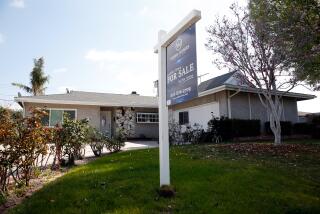Home Sales Jump 7.5%; Leading Indicators Up
- Share via
WASHINGTON — Sales of new homes surged at the fastest clip in a decade during May, and a key economic forecasting gauge moved steadily higher, according to government and industry reports released Tuesday, as Federal Reserve Board policymakers met to consider whether to raise interest rates.
Analysts said the Federal Open Market Committee’s job was made tougher by the latest signs of surprising economic resilience as the five-year expansion added steam in the second quarter.
But most thought the Fed would opt today to hold rates steady for now in the absence of clear-cut evidence that growth is churning up inflationary wage and price demands.
An unexpected 7.5% jump in new-home sales during May, to an annualized rate of 828,000--the highest since March 1986, when they hit a rate of 857,000--rattled the bond market, which had anticipated a decline.
Bond prices fell on concern that higher long-term interest rates were not yet high enough to brake the housing market and that the Fed might decide to act preemptively to push them up further in a bid to slow growth.
“It strengthens the hand of those who would argue that the Fed should be taking out anti-inflation insurance,” said Robert Dederick, economic consultant to Northern Trust Co. in Chicago.
But Dederick said Fed action is unlikely before the policymakers’ next scheduled meeting Aug. 20, when they will have a clearer idea of whether the economy is slowing in the second half of the year or whether wages and prices are escalating.
Separately Tuesday, the Conference Board said its index of leading economic indicators, designed to predict economic trends six to nine months ahead, rose for a fourth straight month in May. The index was up 0.3%, the same as in April.
The index measures a basket of economic indicators, from unemployment benefit claims to building permits. Seven of the 11 components were higher in May, while the remainder showed some decline.
Economist Lynn Reaser of Barnett Banks Inc. in Gainesville, Fla., said the string of advances in the leading index “reinforces other signs that the economy is not showing any significant signs of slowing down.”
She said growth in gross domestic product probably hit a 3.9% annual rate in the second quarter and will slow to 2.4% in the third quarter--still above the 2% to 2.25% the Fed views as capable of being sustained without major inflation risk.
The May new-home sales report underlines the durability of the long-running expansion, which began in March 1991. Sales were a whopping 25% above the pace a year earlier, when new homes were being purchased at a rate of 667,000 a year.
The May increase was concentrated in the Midwest, where sales soared 21.3% to 154,000 a year. In the South, they jumped 10.2% to 379,000.
In the West, sales were down 1.7% to an annual rate of 235,000, and in the Northeast they fell 1.6% to a rate of 60,000.
Economist Joel Naroff of First Union bank in Charlotte, N.C., noted that May sales were the highest “since the peak of the 1980s feeding frenzy”.
(BEGIN TEXT OF INFOBOX / INFOGRAPHIC)
New Home Sales
Seasonally adjusted annual rate in thousands od units:
May, 1996: 828
Source: Commerce Department
More to Read
Inside the business of entertainment
The Wide Shot brings you news, analysis and insights on everything from streaming wars to production — and what it all means for the future.
You may occasionally receive promotional content from the Los Angeles Times.










